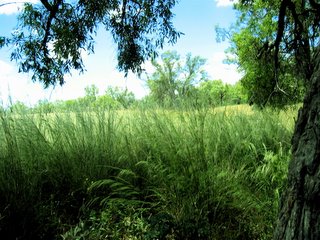
Some of (a lot of) our friends are believe that nature would be great if we left it alone to do its thing. Stop agriculture and let the wilderness reclaim the Earth. (Where they would get the fuel to drive to the supermarket where all the food comes from does not trouble them.) It is a common form of illogic that these mostly-highly educated people can maintain in their logical brains. If white man had not come to Australia, nature would be pristine and the native Aboriginals would be living in peace with each other and the animals.
Well even Tim Flannery (The Future Eaters, The Weather Makers) doesn't believe that. The Aborigines hunted the giant kangaroos and emus and wombats to extinction. They destroyed the natural environment by setting fires to catch prey and provide their prey with fresh pasture, turning the landscape over to the gums and acacias that predominate today.
SO the "noble savage" concept doesn't fly. The Aborigines adapted the earth to their needs, as did the indigenous people of all lands. In New Zealand, the Maori hunted to extinction the big bird that gave them their name - the Moa. The Indians of the Amazon jungle had completely transformed it before Columbus arrived in 1492, according to an article in Atlantic Monthly entitled "1491" by Charles Mann. "Indian societies had an enormous environmental impact on the jungle. Indeed, some anthropologists have called the Amazon forest itself a cultural artefact - that is, an artificial object," he wrote. "Amazonia is all human-created."
Scientists believe there is an area the size of France - 10% of the Amazonian Forest - where the soil has the curious capability of being able to regenerate itself, resisting the nutrient-depleting effect of heavy rainfall that makes so much forest soil poor. Soil geographer WIlliam Woods from Southern Illinois University believes humans created this self-regenerating soil as part of a process of transforming the jungle which was interrupted by the arrival of Columbus. The bison plains of North America were similarly transformed by man. "Rather than domesticating animals for meat, Indians retooled whole ecosystems to grow bumper crops of elk, deer, and bison. They did this by using fire to keep down underbrush and 'create open grassy conditions favourable for game," writes Mann.
The "Leave It Aloners" who market the strategy that says the only way to heal the earth is to leave it alone "are, at the very least, guilty of false advertising," writes Dan Daggert in Gardeners of Eden.
In fact, long term human habitation leads to species stability and diversity, according to ethnobiologist Gary PAul NAbham in his book Cultures of Habitat. Comparing maps of continental America, he discovered that "where human populations had stayed in the same place for the greatest duration, fewer plants and animals had become endangered species; in parts of the country where massive in-migrations and exoduses were taking place, more had become endangered." Where humans are only visitors - like wilderness areas, the habitats society defines as most pristine - plant and animal populations have been less stable and less diverse. "This is the opposite of what we are told by contemporary environmentalism," says Mr Daggert.
The same effect has been recorded in Africa. Allan Savory, who invented Holistic Resource Management, is a conservationist who has proved that "locking away" land from herding animal impact leads not to a flourishing of plant life, but to desertification as much as overstocking does.
So the world's indigenous populations - who had never heard of or seen the Bible - have since time immemorial following Yahwey's instruction to Adam to "go forth and subdue the earth".
For there can be no simplistic green solution that obeys the Laws of Leave It Alone - even if you hunt mankind to extinction. Logically you cannot protect species diversity by eliminating species.
Leave It Alone is emotionally satisfying and superficially appealing. But a less blinkered view reveals that it is caring engagement that nature requires, agricultural practices that restore the soil to health so it can provide sustenance in a mutually-regenerative relationship with man as its steward.
Then we can understand the meaning of the ancient Hasidic saying: "When you walk across the fields with your mind pure and holy, then from all the stones, and all growing things, and all animals, the sparks of their soul come out and cling to you, and then they are purified and become a holy fire in you." Mutual regeneration.




No comments:
Post a Comment